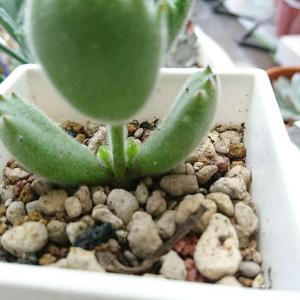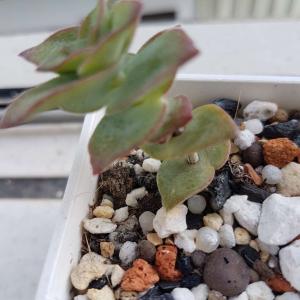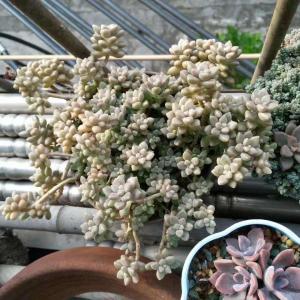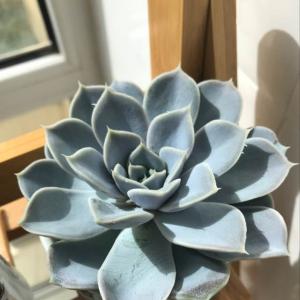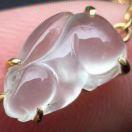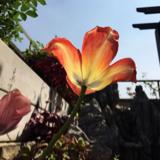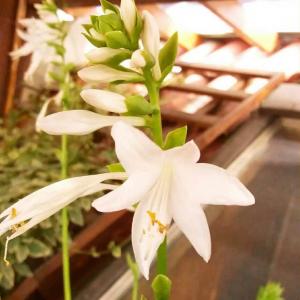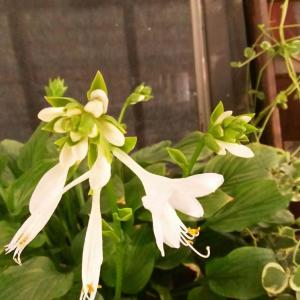文章
Miss Chen
2018年03月27日

Description: This biennial wildflower forms a low rosette of leaves about 8-12" across during the first year. During the second year, it bolts and becomes 2-7' tall. Usually, this wildflower is unbranched, although sometimes ascending lateral branches develop along the upper one-third of a large plant. The central stem (and any lateral stems) is rather stout, terete, and light green to pale purple; it is usually hairy along the lower half of its length, becoming hairless and slightly glaucous along the upper half. The alternate leaves are up to 6" long and 2" across, becoming gradually smaller as they ascend the stem; they are pinnatifid with pointed irregular lobes and dentate along their margins. The upper surfaces of these leaves are medium green and often sparsely hairy; their lower surfaces are pale green and hairy, particularly along the midribs.
The basal leaves are similar to the alternate leaves, except they tend to be larger in size and more wide toward their tips (narrowly obovate to obovate). Young developing basal leaves are usually very hairy on both their upper and lower surfaces. The central stem (and any lateral stems) terminates in an elongated panicle of flowerheads about 6-12" long and 2-4" across. The branches of the panicle are light green to reddish purple, terete, and usually hairless. Each flowerhead is about 1/3" (8-10 mm.) across when fully open, consisting of 12-25 ray florets, no disk florets, and light green to purple floral bracts that are arranged in about 3 series around its base (involucre); this base is about 2/3–3/4" (15-20 mm.) long. The rays of the flowerhead are colored salmon to brick-red and their tips are truncate and finely toothed. The outer floral bracts are shorter than the inner floral bracts.

The blooming period occurs from mid-summer to early fall and usually lasts about 3 weeks. Individual flowerheads last only a single day, blooming for only a few hours on sunny days. After only a short period of time, individual flowerheads are replaced by small black achenes with tufts of white hair. Each achene is 4-5 mm. long, ellipsoid-oblanceoloid in shape, and flattened; the tuft of white hairs is attached to the achene by a slender white beak about 2.5–3.5 mm. long. These achenes are distributed by the wind. The root system consists of a taproot. This wildflower reproduces by reseeding itself.
Cultivation: The preference is partial sun, mesic to dry conditions, and somewhat acidic sandy or rocky soil. The size of individual plants is highly variable, depending on moisture levels and soil fertility.

Range & Habitat: Red-Flowered Wild Lettuce is a rare native plant in Illinois and it is state-listed as 'endangered.' Thus far, this species has been collected from a single county in southern Illinois (see Distribution Map). Because this species can be confused with other Lactuca spp., it may occur in other areas of the state. Outside of Illinois, this species is also uncommon. Habitats include upland rocky woodlands, woodland openings, woodland borders, upland savannas, sandstone glades, pastures, and abandoned fields. These habitats also include sandy areas. Red-Flowered Wild Lettuce prefers some disturbance to reduce the abundance of woody vegetation.

Faunal Associations: Little is known about floral-faunal relationships for this particular species. The flowerheads are probably cross-pollinated by various bees (medium- to small-sized), which offer nectar and pollen. In general, the caterpillars of some moths feed on Lactuca spp. (Wild Lettuce species), including Autographa precationis (Common Looper Moth), Grammia virgo (Virgin Tiger Moth), and Cucullia intermedia (Intermediate Cucullia). The caterpillars of the last moth species feed on the flowerheads. Other insect feeders include Thrips physapus (Dandelion Thrips) and several aphid species: Hyperomyza lactucae (Currant-Sowthistle Aphid), Nasonovia ribisnigri (Currant-Lettuce Aphid), Pemphigus bursarius (Lettuce Root Aphid), Prociphilus erigeronensis (White Aster Root Aphid), Uroleucon ambrosiae (Brown Ambrosia Aphid), Uroleucon gravicorne (Aphid sp.), Uroleucon pseudambrosiae (False Ambrosia Aphid), Uroleucon rudbeckiae (Golden Glow Aphid), and Uroleucon sonchella (Sowthistle Aphid). Among vertebrate animals, the Eastern Goldfinch eats the seeds, while White-Tailed Deer occasionally graze on the foliage of Lactuca spp.
Photographic Location: The wildflower garden of the webmaster in Urbana, Illinois.

Comments: This unusual species has been sadly neglected from many wildflower field guides. Although it has an extensive range in the eastern half of the United States, Red-Flowered Wild Lettuce appears to be uncommon to rare in most areas. The preceding description applies to var. sanguinea, rather the typical variety. In other areas of its range, Lactuca hirsuta may have yellow flowerheads and the hairiness of its stems and leaves can be variable (from nearly hairless to very hairy). Red-Flowered Wild Lettuce can be easily confused with the more common Lactuca canadensis (Common Wild Lettuce), which is itself a rather variable species. Generally, Common Wild Lettuce has flowerheads that are pale yellow to dull orange, flowerheads with shorter bases (involucres) that are ½" or less, and shorter achenes (less than 4 mm. long). Common Wild Lettuce is usually completely glabrous (except for some hairs along the lower midribs of its leaves), and its upper stems and floral branches are usually less purple. Another species, Lactuca biennis (Tall Blue Lettuce), has light blue to cream-colored flowerheads and its achenes have shorter beaks and tufts of tawny or gray hair, rather than white hair. These different Lactuca spp. cannot be identified reliably unless the flowerheads or tufted achenes are available for examination. Another common name of Lactuca hirsuta is Hairy Wild Lettuce.
The basal leaves are similar to the alternate leaves, except they tend to be larger in size and more wide toward their tips (narrowly obovate to obovate). Young developing basal leaves are usually very hairy on both their upper and lower surfaces. The central stem (and any lateral stems) terminates in an elongated panicle of flowerheads about 6-12" long and 2-4" across. The branches of the panicle are light green to reddish purple, terete, and usually hairless. Each flowerhead is about 1/3" (8-10 mm.) across when fully open, consisting of 12-25 ray florets, no disk florets, and light green to purple floral bracts that are arranged in about 3 series around its base (involucre); this base is about 2/3–3/4" (15-20 mm.) long. The rays of the flowerhead are colored salmon to brick-red and their tips are truncate and finely toothed. The outer floral bracts are shorter than the inner floral bracts.

The blooming period occurs from mid-summer to early fall and usually lasts about 3 weeks. Individual flowerheads last only a single day, blooming for only a few hours on sunny days. After only a short period of time, individual flowerheads are replaced by small black achenes with tufts of white hair. Each achene is 4-5 mm. long, ellipsoid-oblanceoloid in shape, and flattened; the tuft of white hairs is attached to the achene by a slender white beak about 2.5–3.5 mm. long. These achenes are distributed by the wind. The root system consists of a taproot. This wildflower reproduces by reseeding itself.
Cultivation: The preference is partial sun, mesic to dry conditions, and somewhat acidic sandy or rocky soil. The size of individual plants is highly variable, depending on moisture levels and soil fertility.

Range & Habitat: Red-Flowered Wild Lettuce is a rare native plant in Illinois and it is state-listed as 'endangered.' Thus far, this species has been collected from a single county in southern Illinois (see Distribution Map). Because this species can be confused with other Lactuca spp., it may occur in other areas of the state. Outside of Illinois, this species is also uncommon. Habitats include upland rocky woodlands, woodland openings, woodland borders, upland savannas, sandstone glades, pastures, and abandoned fields. These habitats also include sandy areas. Red-Flowered Wild Lettuce prefers some disturbance to reduce the abundance of woody vegetation.

Faunal Associations: Little is known about floral-faunal relationships for this particular species. The flowerheads are probably cross-pollinated by various bees (medium- to small-sized), which offer nectar and pollen. In general, the caterpillars of some moths feed on Lactuca spp. (Wild Lettuce species), including Autographa precationis (Common Looper Moth), Grammia virgo (Virgin Tiger Moth), and Cucullia intermedia (Intermediate Cucullia). The caterpillars of the last moth species feed on the flowerheads. Other insect feeders include Thrips physapus (Dandelion Thrips) and several aphid species: Hyperomyza lactucae (Currant-Sowthistle Aphid), Nasonovia ribisnigri (Currant-Lettuce Aphid), Pemphigus bursarius (Lettuce Root Aphid), Prociphilus erigeronensis (White Aster Root Aphid), Uroleucon ambrosiae (Brown Ambrosia Aphid), Uroleucon gravicorne (Aphid sp.), Uroleucon pseudambrosiae (False Ambrosia Aphid), Uroleucon rudbeckiae (Golden Glow Aphid), and Uroleucon sonchella (Sowthistle Aphid). Among vertebrate animals, the Eastern Goldfinch eats the seeds, while White-Tailed Deer occasionally graze on the foliage of Lactuca spp.
Photographic Location: The wildflower garden of the webmaster in Urbana, Illinois.

Comments: This unusual species has been sadly neglected from many wildflower field guides. Although it has an extensive range in the eastern half of the United States, Red-Flowered Wild Lettuce appears to be uncommon to rare in most areas. The preceding description applies to var. sanguinea, rather the typical variety. In other areas of its range, Lactuca hirsuta may have yellow flowerheads and the hairiness of its stems and leaves can be variable (from nearly hairless to very hairy). Red-Flowered Wild Lettuce can be easily confused with the more common Lactuca canadensis (Common Wild Lettuce), which is itself a rather variable species. Generally, Common Wild Lettuce has flowerheads that are pale yellow to dull orange, flowerheads with shorter bases (involucres) that are ½" or less, and shorter achenes (less than 4 mm. long). Common Wild Lettuce is usually completely glabrous (except for some hairs along the lower midribs of its leaves), and its upper stems and floral branches are usually less purple. Another species, Lactuca biennis (Tall Blue Lettuce), has light blue to cream-colored flowerheads and its achenes have shorter beaks and tufts of tawny or gray hair, rather than white hair. These different Lactuca spp. cannot be identified reliably unless the flowerheads or tufted achenes are available for examination. Another common name of Lactuca hirsuta is Hairy Wild Lettuce.
0
0
文章
Miss Chen
2018年03月27日

Description: This perennial wildflower consists of a rosette of basal leaves, from which a flowering stalk about 1-2' tall is produced. The basal leaves are up to 7" long and 2" across; they are pale green to green, hairless, and oblanceolate or obovate in shape. Their margins are smooth, undulate, slightly dentate, or slightly pinnatifid. The flowering stalk is pale green, hairless, glaucous, terete, and erect. There are 1-2 cauline leaves on the flowering stalk that are ovate in shape and smooth or dentate along their margins. Where the uppermost cauline leaf occurs, the stalk branches into 2-5 ascending peduncles. Each peduncle terminates in a yellow or orange-yellow flowerhead about 1–1½" across. Each flowerhead has many spreading ray florets and no disk florets. Each ray floret is narrowly oblong and yellow or orange-yellow; it has a truncate tip with 5 small teeth. The base of the flowerhead is surrounded by several floral bracts in a single series; each bract is pale green, linear-lanceolate, hairless, glaucous, and about 1/3" (8 mm.) in length or a little longer. The blooming period can occur from late spring to mid-summer and lasts about a month. Later in the year, the ray florets are replaced by small achenes. Each achene is bullet-shaped and truncate at the apex, where it has a tuft of white hairs. The achenes are distributed by the wind. The root system consists of a thickened crown with fibrous roots.

Cultivation: The preference is partial or dappled sunlight and mesic to dry conditions. Different kinds of soil are tolerated, including those containing loam, clay-loam, sand, or rocky material. Water-logged sites should be avoided.
Range & Habitat: The native Two-Flowered Cynthia is occasional to locally common throughout Illinois (see Distribution Map). Habitats include open upland woodlands, open sandy woodlands, savannas and sandy savannas, rocky wooded slopes, thinly wooded bluffs, areas along woodland paths, rocky glades, and upland meadows. Two-Flowered Cynthia is often found in upland habitats where Oaks are dominant in areas with thin leaf cover and sparse ground vegetation.
Faunal Associations: The flowerheads attract long-tongued bees (bumblebees, honeybees, Little Carpenter bees, Cuckoo bees, Mason bees), short-tongued bees (Halictid bees, Masked bees), predatory wasps, flies (Syrphid, Tachinid, & others), butterflies, skippers, and beetles. These insects suck nectar, collect pollen, or feed on pollen from the flowerheads. An oligolectic visitor, Andrena krigiana (Krigia Andrenid Bee), is specifically attracted to the flowerheads of Krigia spp. In addition to these floral visitors, an aphid, Uroleucon brachychaetum, sucks plant juices from these plants. Thus far, I have not observed any evidence that White-Tailed Deer feed on the foliage of Two-Flowered Cynthia, which contains a bitter white latex, although I would not rule out this possibility.
Photographic Location: The photographs were taken along the edge of two wooded bluffs in Vermilion County, Illinois.
Comments: The flowerheads and foliage of this wildflower are quite attractive. Most members of the Aster family with dandelion-like flowerheads (including other Krigia spp. in Illinois) have yellow ray florets, but the ray florets of Two-Flowered Cynthia often have an orange tint. Two-Flowered Cynthia has larger flowerheads (1" across or more), longer floral bracts (1/3" or more), and its achenes have more bristly hairs (20 or more) than either Krigia virginica or Krigia caespitosa (both annuals). Another species, Krigia dandelion (Potato Dandelion) has unbranched flowering stalks that each produce a single flowerhead. In contrast, Two-Flowered Cynthia has flowering stalks that branch above their uppermost cauline leaves, each stalk producing 2-5 flowerheads on separate peduncles.

Cultivation: The preference is partial or dappled sunlight and mesic to dry conditions. Different kinds of soil are tolerated, including those containing loam, clay-loam, sand, or rocky material. Water-logged sites should be avoided.
Range & Habitat: The native Two-Flowered Cynthia is occasional to locally common throughout Illinois (see Distribution Map). Habitats include open upland woodlands, open sandy woodlands, savannas and sandy savannas, rocky wooded slopes, thinly wooded bluffs, areas along woodland paths, rocky glades, and upland meadows. Two-Flowered Cynthia is often found in upland habitats where Oaks are dominant in areas with thin leaf cover and sparse ground vegetation.
Faunal Associations: The flowerheads attract long-tongued bees (bumblebees, honeybees, Little Carpenter bees, Cuckoo bees, Mason bees), short-tongued bees (Halictid bees, Masked bees), predatory wasps, flies (Syrphid, Tachinid, & others), butterflies, skippers, and beetles. These insects suck nectar, collect pollen, or feed on pollen from the flowerheads. An oligolectic visitor, Andrena krigiana (Krigia Andrenid Bee), is specifically attracted to the flowerheads of Krigia spp. In addition to these floral visitors, an aphid, Uroleucon brachychaetum, sucks plant juices from these plants. Thus far, I have not observed any evidence that White-Tailed Deer feed on the foliage of Two-Flowered Cynthia, which contains a bitter white latex, although I would not rule out this possibility.
Photographic Location: The photographs were taken along the edge of two wooded bluffs in Vermilion County, Illinois.
Comments: The flowerheads and foliage of this wildflower are quite attractive. Most members of the Aster family with dandelion-like flowerheads (including other Krigia spp. in Illinois) have yellow ray florets, but the ray florets of Two-Flowered Cynthia often have an orange tint. Two-Flowered Cynthia has larger flowerheads (1" across or more), longer floral bracts (1/3" or more), and its achenes have more bristly hairs (20 or more) than either Krigia virginica or Krigia caespitosa (both annuals). Another species, Krigia dandelion (Potato Dandelion) has unbranched flowering stalks that each produce a single flowerhead. In contrast, Two-Flowered Cynthia has flowering stalks that branch above their uppermost cauline leaves, each stalk producing 2-5 flowerheads on separate peduncles.
0
0
文章
Miss Chen
2018年03月18日

Description: This perennial plant is 3-7' tall and usually unbranched. The central stem is light green and glabrous, except where the whorls of leaves of occur, where it is slightly swollen and purple. There are 3-4 leaves in each whorl along the stem. The leaves are about 6" long and 3½" across, or sometimes larger; they are broadly lanceolate or ovate and crenate-serrated along the margins. Each leaf is dull green and hairless on the upper surface; the lower surface is pale green and hairless to finely pubescent. The foliage may be vanilla-scented, although this varies with the local ecotype.
The central stem terminates in one or more panicles of compound flowers that are bunched together; this inflorescence is usually more dome-shaped than flat-topped. Unlike the central stem, the stalks of the inflorescence are sometimes finely pubescent. Each compound flower consists of 5-8 disk florets and several overlapping series of bracts at its base. There are no ray florets. The corolla of each disk floret is whitish pink to purplish pink; it is tubular in shape and has 5 tiny teeth along its upper rim. A divided white style is strongly exerted from each disk floret. The floral bracts are pale pink and oblong. The blooming period occurs from mid-summer to early fall and lasts about a month. Each floret is replaced by a bullet-shaped achene with a small tuft of hair. These achenes are dispersed by the wind. The root system is shallow and fibrous.

Cultivation: The preference is light shade to partial sun, moist to mesic conditions, and a rich loamy soil. The leaves will turn an unattractive yellowish green in the presence of strong sunlight.
Range & Habitat: The native Sweet Joe-Pye Weed occurs occasionally in most areas of Illinois, except for a few counties in SE Illinois and elsewhere in the state, where it is uncommon or absent (see Distribution Map). Habitats include open woodlands, savannas, woodland borders, thickets, partially shaded seeps, and partially shaded riverbanks. This plant can survive in wooded areas that are somewhat degraded. However, populations have a tendency to decline when the shade of overhead canopy trees becomes too dense.

Faunal Associations: The flower nectar attracts primarily long-tongued bees, butterflies, skippers, and moths. Bee visitors include Bombus spp. (bumblebees), Melissodes spp. (miner bees), and Megachile spp. (leaf-cutting bees). Some bees also collect pollen. The caterpillars of various moths feed on leaves and other parts of Eutrochium spp. (Joe-Pye Weed species), including Carmenta bassiformis (Eupatorium Borer Moth), Emmelina monodactyla (Common Plume Moth), Perigea xanthioides (Red Groundling), Schinia trifasciata (Three-Lined Flower Moth), Phragmatobia fuliginosa (Ruby Tiger Moth), and Eupithecia miserulata (Common Pug).

Other insect feeders include larvae of the leaf-mining flies Liriomyza pusilla and Phytobia allecta, larvae of Dasineura purpurea (Joe-Pye Blossum Midge), the warty leaf beetle Exema dispar, the aphid Uroleucon eupatoricolens, and the treehopper Entylia bactriana. White-Tailed Deer browse on the leaves of Sweet Joe-Pye Weed sparingly (personal observation), while the Swamp Sparrow eats the seeds of various Joe-Pye Weed species to a limited extent.
Photographic Location: A small opening in a wooded area at Meadowbrook Park in Urbana, Illinois.

Comments: Sweet Joe-Pye Weed (Eutrochium purpureum) is one of the taller wildflowers in wooded areas. It is often found in habitats that are more shady and dry than other Eutrochium spp. (Joe-Pye Weed species) in the state. To identify a Joe-Pye Weed, it is helpful to examine the central stem: the stem of Sweet Joe-Pye Weed is solid in cross-section and purple where the bases of leaf petioles occur, otherwise it is green and glabrous. The species Eutrochium maculatum (Spotted Joe-Pye Weed) has solid stems that are either purple-spotted and glabrous or solid purple throughout from dark-colored hairs, while Eutrochium fistulosum (Hollow-stemmed Joe-Pye Weed) has hollow stems that are glabrous and glaucous. Sweet Joe-Pye Weed usually has only 3-4 leaves per whorl, while Spotted Joe-Pye Weed has 4-5 leaves per whorl and Hollow-Stemmed Joe-Pye Weed has 4-7 leaves per whorl. Joe-Pye Weed species have been assigned recently to the Eutrochium genus; in the past, they have been assigned to the Eupatorium genus and the Eupatoriadelphus genus. Thus, Eupatorium purpureum and Eupatoriadelphus purpureus are scientific synonyms of Sweet Joe-Pye Weed.
The central stem terminates in one or more panicles of compound flowers that are bunched together; this inflorescence is usually more dome-shaped than flat-topped. Unlike the central stem, the stalks of the inflorescence are sometimes finely pubescent. Each compound flower consists of 5-8 disk florets and several overlapping series of bracts at its base. There are no ray florets. The corolla of each disk floret is whitish pink to purplish pink; it is tubular in shape and has 5 tiny teeth along its upper rim. A divided white style is strongly exerted from each disk floret. The floral bracts are pale pink and oblong. The blooming period occurs from mid-summer to early fall and lasts about a month. Each floret is replaced by a bullet-shaped achene with a small tuft of hair. These achenes are dispersed by the wind. The root system is shallow and fibrous.

Cultivation: The preference is light shade to partial sun, moist to mesic conditions, and a rich loamy soil. The leaves will turn an unattractive yellowish green in the presence of strong sunlight.
Range & Habitat: The native Sweet Joe-Pye Weed occurs occasionally in most areas of Illinois, except for a few counties in SE Illinois and elsewhere in the state, where it is uncommon or absent (see Distribution Map). Habitats include open woodlands, savannas, woodland borders, thickets, partially shaded seeps, and partially shaded riverbanks. This plant can survive in wooded areas that are somewhat degraded. However, populations have a tendency to decline when the shade of overhead canopy trees becomes too dense.

Faunal Associations: The flower nectar attracts primarily long-tongued bees, butterflies, skippers, and moths. Bee visitors include Bombus spp. (bumblebees), Melissodes spp. (miner bees), and Megachile spp. (leaf-cutting bees). Some bees also collect pollen. The caterpillars of various moths feed on leaves and other parts of Eutrochium spp. (Joe-Pye Weed species), including Carmenta bassiformis (Eupatorium Borer Moth), Emmelina monodactyla (Common Plume Moth), Perigea xanthioides (Red Groundling), Schinia trifasciata (Three-Lined Flower Moth), Phragmatobia fuliginosa (Ruby Tiger Moth), and Eupithecia miserulata (Common Pug).

Other insect feeders include larvae of the leaf-mining flies Liriomyza pusilla and Phytobia allecta, larvae of Dasineura purpurea (Joe-Pye Blossum Midge), the warty leaf beetle Exema dispar, the aphid Uroleucon eupatoricolens, and the treehopper Entylia bactriana. White-Tailed Deer browse on the leaves of Sweet Joe-Pye Weed sparingly (personal observation), while the Swamp Sparrow eats the seeds of various Joe-Pye Weed species to a limited extent.
Photographic Location: A small opening in a wooded area at Meadowbrook Park in Urbana, Illinois.

Comments: Sweet Joe-Pye Weed (Eutrochium purpureum) is one of the taller wildflowers in wooded areas. It is often found in habitats that are more shady and dry than other Eutrochium spp. (Joe-Pye Weed species) in the state. To identify a Joe-Pye Weed, it is helpful to examine the central stem: the stem of Sweet Joe-Pye Weed is solid in cross-section and purple where the bases of leaf petioles occur, otherwise it is green and glabrous. The species Eutrochium maculatum (Spotted Joe-Pye Weed) has solid stems that are either purple-spotted and glabrous or solid purple throughout from dark-colored hairs, while Eutrochium fistulosum (Hollow-stemmed Joe-Pye Weed) has hollow stems that are glabrous and glaucous. Sweet Joe-Pye Weed usually has only 3-4 leaves per whorl, while Spotted Joe-Pye Weed has 4-5 leaves per whorl and Hollow-Stemmed Joe-Pye Weed has 4-7 leaves per whorl. Joe-Pye Weed species have been assigned recently to the Eutrochium genus; in the past, they have been assigned to the Eupatorium genus and the Eupatoriadelphus genus. Thus, Eupatorium purpureum and Eupatoriadelphus purpureus are scientific synonyms of Sweet Joe-Pye Weed.
0
0



